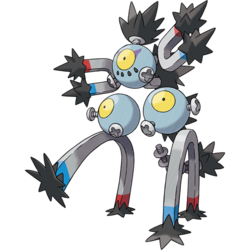From Bulbapedia, the community-driven Pokémon encyclopedia.

|
The subject of this article is a Pokémon which has recently been announced.
This article's contents will change as more information becomes available, perhaps abruptly. Please be cautious when adding information to this article, as rumors and speculation can often be confused with facts. Avoid any information on this subject which is not confirmed by reliable sources.
|
Sandy Shocks (Japanese: スナノケガワ Sunanokegawa) is a dual-type Electric/Ground Paradox Pokémon introduced in Generation IX.
It is not known to evolve into or from any other Pokémon, but it appears to be an ancient relative of Magneton.
Biology
Sandy Shocks is a robotic Pokémon with a body composed of three units that resemble ancient versions of Magnemite, all of which have yellow eyes. The top unit bears markings similar to tribal war paint as well as iron filings on its body and horseshoe magnets that resemble hair. The bottom units have only a single magnet each, which is elongated in a manner that makes them resemble legs and also is covered with iron filings on its end. Instead of floating like Magneton, it walks by bending these magnets. A series of screws with iron filings on the end floats between the two lower units, making it resemble a tail.
It is said to resemble a Magneton that has lived for 10,000 years. Despite multiple sightings of it, no one apparently has been able to capture it. Sandy Shocks is known to be very aggressive, attacking anyone who sees it. It takes its name from a matching description in the Scarlet Book.
In the anime
Major appearances
Minor appearances
In the manga
In the TCG
- Main article: Sandy Shocks (TCG)
Game data
Pokédex entries
| This Pokémon was unavailable prior to Generation IX.
|
| Generation IX
|
|
|
Paldea
#381
|
| Scarlet
|
No records exist of this Pokémon being caught. Data is lacking, but the Pokémon’s traits match up with a creature shown in an expedition journal.
|
| Violet
|
It slightly resembles a Magneton that lived for 10,000 years and was featured in an article in a paranormal magazine.
|
|
|
Game locations
| This Pokémon was unavailable prior to Generation IX.
|
|
|
In side games
Held items
Stats
Base stats
| Stat
|
Range
|
| At Lv. 50
|
At Lv. 100
|
85
|
|
145 - 192
|
280 - 374
|
81
|
|
77 - 146
|
150 - 287
|
97
|
|
91 - 163
|
179 - 322
|
121
|
|
113 - 190
|
222 - 375
|
85
|
|
81 - 150
|
157 - 295
|
101
|
|
95 - 168
|
186 - 331
|
Total: 570
|
Other Pokémon with this total
|
- Minimum stats are calculated with 0 EVs, IVs of 0, and (if applicable) a hindering nature.
- Maximum stats are calculated with 252 EVs, IVs of 31, and (if applicable) a helpful nature.
|
Type effectiveness
| Under normal battle conditions in Generation IX, this Pokémon is:
|
|
|
|
|
|
|
|
|
|
|
|
|
Learnset
|
|
|
|
- Bold indicates a move that gets STAB when used by Sandy Shocks
- Italic indicates a move that gets STAB only when used by an Evolution of Sandy Shocks
|
|
|
|
|
- Bold indicates a move that gets STAB when used by Sandy Shocks
- Italic indicates a move that gets STAB only when used by an Evolution or an alternate form of Sandy Shocks
|
|
|
|
|
- Moves marked with an asterisk (*) must be chain bred onto Sandy Shocks
- Bold indicates a move that gets STAB when used by Sandy Shocks
- Italic indicates a move that gets STAB only when used by an Evolution of Sandy Shocks
|
Side game data
Evolution
Sprites
Trivia
Origin
Sandy Shocks is based on Magneton. The tufts around and on its body may be iron filings, and they resemble the messy and unkempt hair that cavemen are typically depicted to have. Its stilt-like legs and elongated tail may serve to reference dinosaurs of the diplodocidae family.
Name origin
Sandy Shocks is literally sandy shocks. The word shock may refer to both a burst of electrical energy and a tuft of hair or fur.
Sunanokegawa can be taken literally as 砂の毛皮 suna no kegawa (sandy fur).
In other languages
| Language
|
Title
|
Meaning
|
 Japanese Japanese
|
スナノケガワ Sunanokegawa
|
From 砂の毛皮 suna no kegawa
|
 French French
|
Pelage-Sablé
|
From pelage and sablé
|
 Spanish Spanish
|
Pelarena
|
From pelaje and arena
|
 German German
|
Sandfell
|
From Sand and Fell
|
 Italian Italian
|
Peldisabbia
|
From pelo di sabbia
|
 Korean Korean
|
모래털가죽 Moraeteolgajuk
|
From 모래털가죽 morae teolgajuk
|
 Mandarin Chinese Mandarin Chinese
|
沙鐵皮 / 沙铁皮 Shātiěpí
|
From 沙 shā, 鐵 / 铁 tiě, and 皮 pí
|
 Cantonese Chinese Cantonese Chinese
|
沙鐵皮 Sātitpèih
|
From 沙 sā, 鐵 tit, and 皮 pèih
|
|
|
|
|
|
|
|
Related articles
External links

|
This Pokémon article is part of Project Pokédex, a Bulbapedia project that aims to write comprehensive articles on each Pokémon species, as well as Pokémon groups and forms.
|



